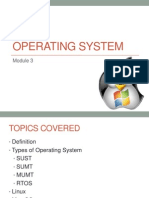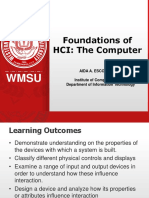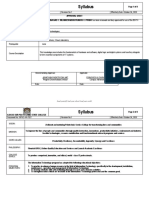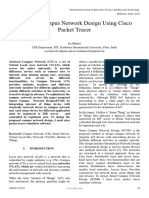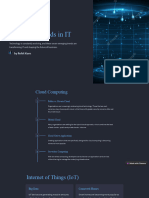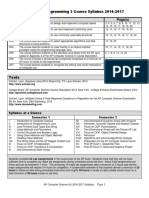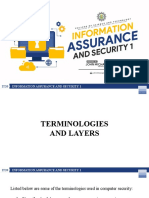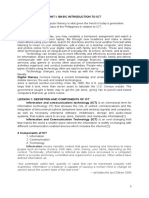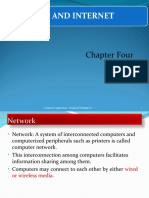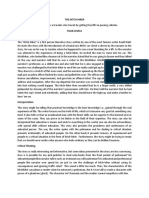0 ratings0% found this document useful (0 votes) 179 views4 pagesUnit 7 Computer Network
Copyright
© © All Rights Reserved
We take content rights seriously. If you suspect this is your content,
claim it here.
Available Formats
Download as PDF or read online on Scribd
Computer Systems and IT Applications
Unit 7: Computer Network
Introduc'
n
© A computer network is an interconnected collection of autonomous computers.
‘© Two computers are said to be interconnected if they can exchange information or data.
‘© A computer network consists of end systems (or) nodes that are capable of transmitting
information and which communicate through a transit system interconnecting them.
Pros of Computer Network
Convenient resource sharing
‘+ Connected peripheral devices like printers, scanners and copiers, or sharing software
between multiple users, saves money.
‘+ Very important, particularly for larger companies that really need to produce huge numbers
of resources to be shared to all the people.
Easy sharing of files
‘+ Using cloud services such as google drive and dropbox, users can upload files to a cloud
server such that it is made available to other people.
+ Users can access and download the required files even if they are in remote locations.
Inexpensive system
‘+ Inexpensive networking software is installed once and made available for all of the
connected computers.
‘+ No need to purchase the software frequently for each and every user.
Highly flexible
‘+ Contain various information sharing options that can be convenient to different individuals
‘+ Using emails, or social networking sites like facebook or cloud services like Google drive,
files or information can be shared among various users/devices.
Increases storage capacity
+ Many computers are interconnected through a central server.
‘+ If in case one of the computer happens to loose data, there won't be any problem in
retrieval since all the information are already stored inside the central server.
‘SUWAS KARKI | Unit 7: Computer Network�Computer Systems and IT Applications
Cons of Computer Network
Risk of security issues
‘+ Since a large number of users are using the network, it posses many security risks.
‘+ There might be illegal activities that will occur so user need to be aware and be careful all
the time.
‘+ Preventing theft and other illegal activities, various security tools such as firewall is used
The doorway for computer viruses
‘+ If one of the computer happens to get infected with viruses, there are high chances of
them spreading to remaining computers.
‘+ Similar instances can happen if the central server becomes infected.
‘+ For avoiding this, the network administrator should regularly scan for viruses.
Needs an efficient handler
‘+ More technically sound person needed for network operations and administration.
‘+ Network configuration and connection is very tedious and cannot be done by an average
technician who does not have advanced knowledge.
Lack of independence
‘+ People will be relying more of computer work, instead of exerting an effort for their tasks
at hand.
+ Users will be dependent on the main file server, which means that, if it breaks down, the
system would become useless, making users idle.
Lack of robustness
‘+ Incase if the server breaksdown, the system cannot be used anymore.
‘+ Also if bridging device or a central linking server fails, the entire network would also come
toa standstill.
Types of Computer Network
* Networks can be categorized in many different ways, by their scope, their architecture,
ete.
‘SUWAS KARKI | Unit 7: Computer Network�Computer Systems and IT Applications
Based on Size/Scope of Network Coverage
Local Area Network (LAN)
© Local Area Network is a group of computers connected to each other in a small area
such as building, office.
‘* LANs used for connecting two or more personal computers through a communication
medium such as twisted pair, coaxial cable, etc.
* Itis less costly as itis built with inexpensive hardware such as hubs, network adapters,
and Ethernet cables.
The data is transferred at an extremely faster rate in Local Area Network.
Local Area Network provides higher security.
Metropolitan Area Network (MAN)
© Ametropolitan area network is a network that covers a larger geographic area by
interconnecting a different LAN to form a larger network.
© Government agencies use MAN to connect to the citizens and private industries.
© For e.g. communication between the banks in a city.
Wide Area Network (WAN)
© A Wide Area Network is a network that extends over a large geographical area such as
states or countries.
A Wide Area Network is quite bigger network than the LAN.
‘AWide Area Network is not limited to a single location, but it spans over a large
‘geographical area through a telephone line, fiber optic cable or satellite links.
The internet is one of the biggest WAN in the world.
Widely used in the field of business, government, and education.
Based on Architecture
* Peer-to-Peer(P2P)
© Each computer has equivalent capabilities and responsibilities,
© Generally simpler and less expensive,
© Mostly used for file sharing.
© Client/Server
© One or more server manages shared resources and security and administers the
other network users and computers.
© Clients depend on the server for data and software.
‘SUWAS KARKI | Unit 7: Computer Network�Computer Systems and IT Applications
Introduction to IP Addresses (IPv4 and IPv6)
An internet protocol address (IP address) is a numerical label assigned to each device
(computer, printer, etc.) participating in a computer network.
Two versions of the IP address are available.
° IPv4
© Ipvé
Addresses in IPv4 are 32 bit long, hence allows for a maximum of 2°? unique addresses.
‘Addresses in IPv6 are 128 bit long, hence allows for a maximum of 2'* unique addresses.
IP addresses are binary numbers but are typically expressed in decimal form (IPv4) or
hexadecimal form (IPv6) to make reading and using them easier for humans.
IPv4 is expressed by four numbers separated by dots.
© 192,168.11
IPV6 is expressed by 8 groups of hexadecimal numbers separated by colons.
© 2001:odba:0000:0000:0000:0000:3257:9652
= 2001:cdba::3257:9652
© Consecutive sections of zeros can be represented by a double
colon (::)
A domain name is a text name corresponding to the numeric IP address.
IP addresses are for computers whereas domain name/addresses are for humans.
Domain Name System (DNS) allows a translation between the domain name and IP
addresses.
Internet is based an IP addresses not domain names. Every web server requires a DNS
server to translate domain names into IP addresses.
Public and Private IP Address
A public IP address is used to identify the computer uniquely on the intemet (public
network)
Public IP address is basically assigned by the ISP (Intemet Service Provider).
Itis not available in free of cost.
Public IP can be known by searching “what is my ip” on google.
A private IP address is used for a private network
Using private IP data or information can be sent or received within the same network.
Itis available in free of cost.
Private IP can be known by entering “ipconfig” on command prompt
‘SUWAS KARKI | Unit 7: Computer Network
